“To write is human, to edit is divine.” – Stephen King
Introduction
Proofreading and Editing is an indispensable part of Content Writing. Ensuring that you always give time to proofreading and editing of your blog post, can make a huge difference.
Proofreading is the process of going through a piece of written content to check for errors and ensure that every possible mistake is corrected.
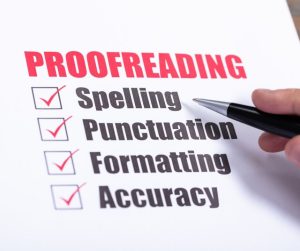
According to research, 59% of consumers say they would not trust a website with poor grammar or spelling errors
Additionally, Businesses that take the time to proofread their content report an average 10% increase in conversion rates due to improved readability and trustworthiness
In this comprehensive guide, we will show you 13 important things to check whenever you proofread your blog post.
By the time you’re done reading this article, you’d be well equipped to publish greater quality of content on your website.
Also note that the proofreading lessons taught in this guide mostly apply, specifically, to SEO Content Writing or Blog Posts, and not to general writing.
Without wasting much time let’s get right in to it.
13 Things to Check when Proofreading and Editing Your Blog Post
1. Punctuation
In content writing, do not ignore the importance of Punctuation marks. Read your blog post line by line, patiently going through the whole work so that you don’t skip any mistake.
Punctuation mistakes are pretty common, and they can totally change the meaning of a sentence, which is why it’s so important to get them right. Let’s walk through some examples where the punctuation is off, and see how a simple tweak can make all the difference.
Examples;
- Lets go to the gym (Incorrect)
Let’s go to the gym (Correct)
- Mr president said I will fire him (Incorrect)
Mr president said, ‘I will fire him’ (Correct)
- Let’s eat mummy ( Incorrect)
Let’s eat, mummy (Correct)
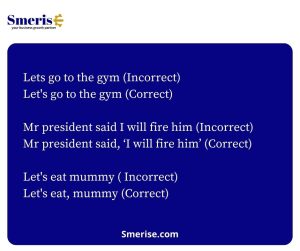
What did you observe from the above examples? You can change the entire meaning of a sentence by just a slight mistake in punctuation.
That is how sensitive punctuation marks can be. It requires extra attention to ensure every mistake is corrected
“The difference between the right word and the almost right word is the difference between lightning and a lightning bug.” – Mark Twain
2. Sentence Structure
In creating engaging Blog Posts, it’s important to make your copy easy to read. It’s also important to keep your readers focused and engaged.
Avoid lengthy sentences, avoid wordy phrases. Keep them as concise as possible.
You know how sometimes you’re writing, and you just keep going and going?
You might throw in a bunch of commas, maybe a semicolon here and there, and suddenly, your sentence is a mile long.
When you take a step back, it’s easy to spot when a sentence is just a bit too crowded. If you notice that you’re stringing together too many thoughts in one go, there’s a good chance you’ve got a run-on sentence on your hands.
Increase Readability
Now, don’t get me wrong—there’s nothing wrong with a long sentence now and then.
But in content writing, we aim to increase readability. If your reader has to pause and untangle the sentence just to figure out what you’re saying, it might be time to rethink it.
Instead of cramming everything into one sentence, try breaking it up into shorter ones. This can make your writing clearer and more digestible.
Think of it in terms of real life conversation. When you talk to someone, you naturally pause between thoughts, right?
The same idea applies to writing. Sometimes it’s more effective to say something in two or three sentences rather than pushing everything into one.
Most times when creating a blog post, it’s good to write as if you’re having a real life conversation with someone.
“A writer’s first draft is never their last draft; it’s the proofreader who makes the magic happen.” – Anonymous
When you’re reviewing or proofreading your blog post, pay attention to those long sentences. Ask yourself if they could be split up.
Chances are, shortening a sentence or two will make your writing flow better and help your ideas come across more clearly.
After all, the goal is to communicate your message in a way that’s easy to follow, not to impress with complicated sentence structures.
Keep it simple, keep it clear, and your readers will thank you for it.
3. Typos
Typographical errors are common in writing. Proofreading enables you to spot out these typographical errors and correct them.
Content Writing requires attention to details. And that is also why proofreading takes time and effort
Publishing blog posts with typographical errors reveals unprofessionalism about you as a content writer. It shows that you do not pay attention to details.
A content writer should be a detailed person.
“Typos are like cockroaches; you don’t want to see one, because if you do, it means there are a lot more that you haven’t spotted.” – Dave Barry
Having typographical errors in your blog posts can also annoy your audience and may result in people leaving your website without spending longer time.

4. Consistency
Consistency in content writing may seem insignificant but it is not.
Keeping things consistent can really polish up your work and make it look professional.
Have you ever noticed how sometimes you might write “Email” in one part of a document and then “E-mail” in another?
It’s a tiny difference, but it stands out, especially to someone who’s reading carefully. The same goes for using symbols like “%” versus spelling out “percent.” Both are perfectly fine, but mixing them up within the same piece of writing can make your work feel a bit disjointed.
Why Does It Matter?
Consistency is kind of like setting a tone or style for your writing. Once you pick a way to do something—whether it’s how you use numbers, abbreviations, or contractions—it’s important to stick with that choice all the way through.
Consistency in content writing is very important because it will make your writing not only clearer but also more professional.
It’s these little touches that can make a big difference in how your work is perceived.
It’s a simple way to elevate your writing.
Stick with It
So, when you’re going through your work, take a moment to check for these little things.
Did you write “30%” in one sentence and then “thirty percent” in the next? Pick one style and stick with it.
And don’t forget about contractions.
If you’re using them, make sure you’re consistent. If you start off using “can’t” and “don’t,” don’t suddenly switch to “cannot” and “do not” unless there’s a good reason.
Pick one and stick with it
The goal is to keep everything flowing smoothly so that your reader isn’t jolted by sudden changes in style.
Another example is, spelling differences in US and UK English.
Do you write color and colour in different parts of the same content?
Or
Theatre and theater, organize and organise, etc.
Pick one and stick with it!
“Proofreading is like a fresh pair of eyes, catching what the writer can’t see anymore.” – Anonymous
5. Proper Nouns
These are special words that refer to something specific, such as the name of a person, an organization, a brand, or a City.
When creating blog posts, these nouns should be written correctly. First, they should be capitalized and spelt correctly.
Imagine that you’re creating a blog post for Hubspot and in referring to the company you write ‘hubspot’ instead of ‘Hubspot’
That would sound disrespectful right ? Yes, that’s true.
Proper Nouns are like the kings of words, it’s important that they are always capitalized.
And when you are writing about a person or a business, ensure to find out the correct spelling for their names.
You can check out their website or LinkedIn profiles.
When proofreading, check out for these nouns and ensure they are capitalized and spelt correctly.
“Proofreading is the last line of defense before your content goes live.” – Anonymous
6. Proper Formatting
Formatting is a crucial element in blog writing that significantly enhances readability and engagement.
Proper formatting, like using short paragraphs, headers, bullet points, and bold text, helps break up the content, making it easier for readers to skim and digest information.
This approach not only keeps readers engaged but also improves their understanding by highlighting key points.
Additionally, good formatting ensures a positive user experience across all devices, particularly on mobile, where readers are likely to abandon poorly formatted content.
Your proofreading is not complete if you did not check for this important element.
Ensure that your formatting is great before you hit “publish”
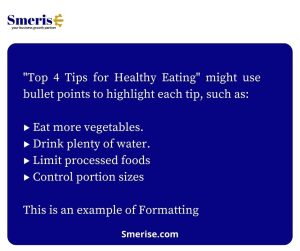
7. Short Paragraphs
This one is supposed to be under “Proper Formatting” but I choose to treat it separately because it is very important
Short paragraphs are crucial for making blog posts more readable and engaging.
In today’s business world, readers often skim content rather than read every word.
Long paragraphs can be overwhelming and discourage readers from continuing, while short paragraphs break up the text, creating white space that makes the content visually appealing and easier to digest.
When Proofreading your blog post, check out this element. Ensure that your content has short paragraphs.
If you spot long paragraphs break it up into digestible bits
8. Acronyms and Initialisms
This is another important thing to check when proofreading our work. We want to ensure that we did not use acronyms or initialisms that our audience is unfamiliar with, without stating their full meaning.
Acronyms
These are the first letters of words in a sequence of words. They are often pronounced as one word. Examples; GOAT( Greatest Of All Time), NATO, RADAR.
Initialisms
These are also abbreviations formed from the first letters of words in a sequence of words but the difference is that they are not read as one word.
They are named individually or separately. Examples; ATM, FBI, CNN etc
In content writing, it is very important to write the full meaning of any acronym or initialism you intend to mention in your content, if your audience is not familiar with it.
This is because we want our blog posts to be clear and easy to understand.
9. Content Flow
In content writing, it’s important to ensure that your paragraphs and sections transition smoothly and that there is a logical flow of ideas.
Content Flow is when your content is structured in such a way that you take your audience naturally from your relatable introduction to the rest of the content
First, your catchy and relatable headline draws in your target audience and gets them to read your blog post.
Then the introduction consolidates it further and each section smoothly moves them down till they get to your call to action
When you proofread your blog post, ensure that there’s a smooth flow of ideas and that each section transitions smoothly and leads to your end goal.
10. Active/Passive Voice
In the English Language, sentences can be written either in Active Voice or Passive Voice. Both are good.
The type of voice depends on the type of content you want to write. For instance academic and scientific writings can go with passive voice.
But in content marketing, writing in the passive voice will not be a good way to go. So when we create blog posts we write in Active Voice.
For example,
- Our MD fired the new HR ( Active Voice)
The new HR was fired by our MD (Passive Voice)
Is there any difference?
The first one is more direct, right?
Check out this blog post for a comprehensive article that explains what active voice is all about.
And why we write in Active Voice when we talk about SEO Content Writing
When you create a blog post, how can you be sure that your content was written in the active voice?
Proofreading helps you solve this. So when you proofread your blog post, ensure that the majority of your sentences are written in the active voice.
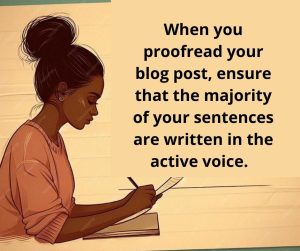
11. Consecutive Sentences
One of the common mistakes writers make is starting consecutive sentences with the same word or phrase.
Sometimes it can be subtle, if we do not pay close attention to details we may not notice them.
That’s why it’s important to check for it during proofreading.
When you proof your work, carefully look out for places where consecutive sentences started with the same words or phrases.
Why is this important to check ?
Because it can affect readability. When people read your blog post and keep seeing such repetitive sentences it can put them off.
Some readers may leave your website as a result of that, and this would affect your bounce rate.
Checking for consecutive sentences is very important during proofreading.
When you proofread your blog post and spot such sentences, rewrite them.
Change the sentence beginnings with different words while still maintaining the overall meaning
We will look at some examples of such sentences for better understanding.
Examples Of Consecutive Sentences
- I went to the market to buy kitchen utensils for my new apartment. And then the seller happened to be my old school make. And then he gave me a whopping discount I never expected. And then I ended up buying more items than I previously budgeted.
- As a result of his carelessness the project was terminated. As a result, our team lost the investor we have been following up for the past few months. As a result, our brand integrity has been lost.
- Due to the ongoing protests, the Church program was canceled. Due to that, some people felt disappointed. Due to this, we lost some new members
12. Headings and Subheadings
Headings and Subheadings help increase readability, thus it becomes very paramount to optimize them well in your blog post.
When Proofreading your blog post, ensure that;
- Your headings and subheadings flow with the rest of the content.
- Your keywords are incorporated naturally in the headings
- They are descriptive ; Your headings should give readers a clear idea of what they’ll find in each section.
Check out this blog post on our website to gain more insight on the Importance of Headings and Subheadings in your Blog Post
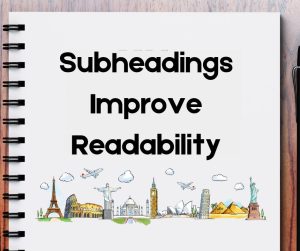
13. Keyword Optimization
If your keywords are stuffed and do not flow naturally, it is an error because it is not good for SEO.
This should be corrected. And your proofreading should fix it. When you proofread your blog post check out for this important factor.
Wherever you observe that keywords do not flow naturally, pause and rewrite.
Ensure that your keywords are not stuffed.
The same way you see spelling and grammar errors as threats to your blog posts, see keyword stuffing as a threat also.
And fix it when you proofread. Because that is actually what it is- a threat.
Let’s Wrap It Up
Proofreading and editing are very essential and indispensable to creating blog posts.
Proofreading improves content clarity. According to research, 70% of readers say they find content more trustworthy when it’s error-free
It’s also important to say this; When you finish creating content, don’t proofread immediately.
Take a short break. Step out of that place. You could take a walk or get busy with some other tasks. Return after a while and proofread.
Personally, I wait for 24 hours before I continue my editing and proofreading.
When we proofread immediately, the chances of making a mistake would be high.
Check out for these 13 Facts each time you want to proofread your blog post.
And If you want to outsource your proofreading and editing for excellent work, feel free to reach out to us, our team will give you a great job.
Want to reach out to our team?
Please say Hi to us on WhatsApp; Hello Team Smerise

